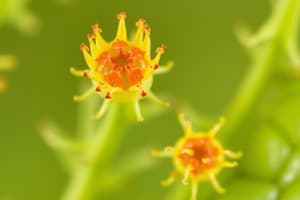Podcast
Questions and Answers
What is the primary function of parenchyma cells in plants?
What is the primary function of parenchyma cells in plants?
Store nutrients, water, and gases; participate in photosynthesis and respiration
How does collenchyma tissue contribute to plant growth?
How does collenchyma tissue contribute to plant growth?
Provides structural support in young, growing tissues; allows for growth and expansion
What is the main difference between sclereids and fibers in sclerenchyma tissue?
What is the main difference between sclereids and fibers in sclerenchyma tissue?
Sclereids are irregular in shape and provide protection, fibers are elongated and provide strength
Where can parenchyma cells be found within a plant?
Where can parenchyma cells be found within a plant?
Flashcards are hidden until you start studying
Study Notes
Simple Permanent Tissues and Their Types: Parenchyma, Collenchyma, and Sclerenchyma
At the heart of plant life lies a marvel of organization, where cells organize into specialized tissues that perform specific functions. Permanent tissues, unlike meristematic tissues that grow and change, are stationary and differentiated into three primary types: parenchyma, collenchyma, and sclerenchyma.
Parenchyma
Parenchyma, the most abundant tissue, consists of living, thin-walled, and loosely arranged cells. These cells store nutrients, water, and gases, and also participate in photosynthesis and respiration. Parenchyma cells are flexible and can change shape, allowing them to fill spaces within the plant, such as the cortex of root and stem, and the mesophyll of leaves.
Collenchyma
Collenchyma, a tough but flexible tissue, is composed of thick-walled, living cells that are rich in cellulose and lignin. Collenchyma provides structural support, mostly in young, growing tissues, and allows for growth and expansion. This tissue helps to maintain the shape and integrity of plant parts like the stems and petioles.
Sclerenchyma
Sclerenchyma is a tough, non-living, and lignified tissue comprised of dead, thick-walled cells that provide mechanical strength and protection to the plant. This tissue can be further divided into two types: sclereids and fibers. Sclereids are thick-walled, round, and irregularly shaped cells that offer resistance to compression, while fibers are elongated, thin-walled cells that provide tensile strength and resistance to stretching. Sclerenchyma can be found in the protective layers of seeds, fruits, and stems, as well as in specialized structures.
Each of these tissues plays a vital role in plant function and structure. Parenchyma provides the metabolic capabilities of the plant, collenchyma lends flexibility and support, and sclerenchyma offers protection and structural strength. These specialized cells work together to make up the complex and diverse world of plant life.
Studying That Suits You
Use AI to generate personalized quizzes and flashcards to suit your learning preferences.



